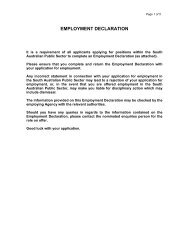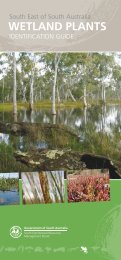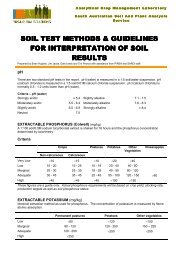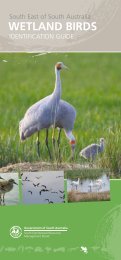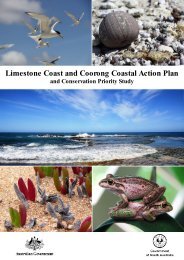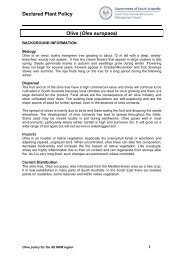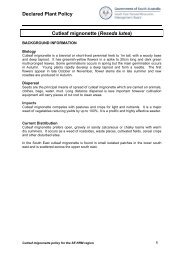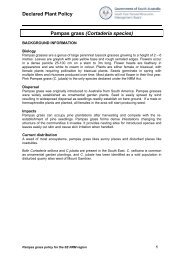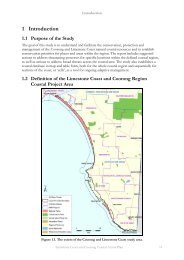Cell Descriptions - South East Natural Resources Management Board
Cell Descriptions - South East Natural Resources Management Board
Cell Descriptions - South East Natural Resources Management Board
You also want an ePaper? Increase the reach of your titles
YUMPU automatically turns print PDFs into web optimized ePapers that Google loves.
SE12 – Cape Jaffa<br />
Climate change<br />
element/ scenario<br />
Combined climate<br />
changes and sea<br />
level rise<br />
throughout this<br />
cell<br />
Sea level rise:<br />
2030 : +c.20cm<br />
2070: +c.80cm.<br />
Storms:<br />
Frequency continues<br />
to show great<br />
variation on a<br />
decadal scale.<br />
Impacts and implications Protect and manage Address landscape<br />
(for this cell) habitat threats issues: fire,<br />
connectivity,<br />
refuges, hydrology<br />
This cell presents a pattern of<br />
dune habitats sensitive to<br />
change.<br />
Increase in beach recession,<br />
storm foredune damage and<br />
dune ridge instability. Loss of<br />
small cliff-backed pocket<br />
beaches.<br />
Foredune damage could lead<br />
to widespread dune destabilisation<br />
and transport of<br />
sand across dunes to the<br />
adjacent farmland.<br />
Shoreline recession in many<br />
places will continue as far as<br />
the calcarenite bluff at the<br />
back of the beach: thus, a<br />
change in the character of the<br />
shoreline, from narrow low<br />
energy beach to low cliffs.<br />
2030: Occasional storm tide<br />
flooding above highest known<br />
tides.<br />
2070: Frequent storm damage<br />
to foredunes.<br />
Create a baseline for<br />
shoreline, dune and<br />
lake change by<br />
establishing a rectified<br />
aerial photographic<br />
record at an<br />
appropriate resolution.<br />
Active management of<br />
dune blowouts.<br />
Maintain an aerial<br />
photographic record<br />
of change.<br />
Create buffer zone to<br />
allow dune retreat<br />
where feasible.<br />
Active management of<br />
dune blowouts.<br />
The creation of<br />
buffer zones to<br />
allow retreat of tide<br />
dependant<br />
ecosystems a<br />
regional issue with<br />
local implications.<br />
Intensity of large<br />
storms increases.<br />
Warmer average<br />
conditions:<br />
2030:+0.3 to.6 0 C<br />
2070:+1.5 to 2 0 C<br />
(Impacts uncertain. Existing<br />
terrestrial vegetation is found<br />
in warmer conditions<br />
elsewhere)<br />
Maintain<br />
connectivity of<br />
vegetation within<br />
the region.<br />
Drier average<br />
conditions:<br />
2030: -2% to 5%<br />
2070: - 10% to 20%<br />
Groundwater<br />
lowering; saline<br />
incursion:<br />
Nearshore sea<br />
Dune vegetation adapts to<br />
drier conditions, but recovers<br />
more slowly from fire and<br />
storm damage allowing weed<br />
colonisation, notably exotic<br />
grasses: dune mobilization<br />
becomes more likely.<br />
Groundwater lowering a threat<br />
to dune vegetation.<br />
Changes are unlikely to affect<br />
Active weed control<br />
within dunes.<br />
Adaptive management<br />
of ecological assets.<br />
Lowering of<br />
regional water table<br />
(and perched water<br />
tables in dunes) a<br />
threat to all habitats.<br />
Limestone Coast and Coorong Coastal Action Plan 417



